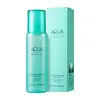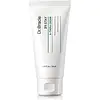What's inside
What's inside
 Key Ingredients
Key Ingredients

 Benefits
Benefits

 Concerns
Concerns

 Ingredients Side-by-side
Ingredients Side-by-side

Water
Skin ConditioningPropanediol
SolventDipropylene Glycol
HumectantBetaine
HumectantAlcohol
AntimicrobialPentylene Glycol
Skin ConditioningSea Water
HumectantCentella Asiatica Extract
CleansingFicus Carica Fruit Extract
HumectantPortulaca Oleracea Extract
Skin ConditioningPueraria Thunbergiana Root Extract
Skin ConditioningGlycyrrhiza Glabra Root Extract
BleachingPaeonia Lactiflora Root Extract
Skin ConditioningCnidium Officinale Root Extract
Skin ConditioningUlmus Davidiana Root Extract
Skin ConditioningAmaranthus Caudatus Seed Extract
Skin ConditioningSargassum Muticum Extract
Skin ProtectingHypnea Musciformis Extract
Skin ProtectingUlva Lactuca Extract
Skin ConditioningEcklonia Cava Extract
Skin ConditioningCodium Tomentosum Extract
Skin ProtectingAgarum Cribrosum Extract
Skin ConditioningEnteromorpha Compressa Extract
Skin ProtectingLaminaria Japonica Extract
Skin ProtectingDunaliella Salina Extract
Skin ConditioningSargassum Fulvellum Extract
Skin ConditioningPorphyra Yezoensis Extract
Skin ConditioningFucus Vesiculosus Extract
EmollientLaminaria Saccharina Extract
Skin ProtectingSpirulina Platensis Extract
Skin ProtectingJania Rubens Extract
Skin ConditioningGelidium Cartilagineum Extract
Skin ProtectingMacrocystis Pyrifera Extract
Skin ConditioningAlgae Extract
EmollientUndaria Pinnatifida Extract
Skin ConditioningCodium Fragile Extract
Skin ConditioningLaminaria Cloustoni Extract
Skin ProtectingChlorella Minutissima Extract
Skin ConditioningHizikia Fusiforme Extract
Skin ConditioningSalicornia Herbacea Extract
Skin ConditioningPikea Robusta Extract
AntioxidantHydrolyzed Algae Extract
Skin ConditioningHydrolyzed Ulva Lactuca Extract
Skin ConditioningHaematococcus Pluvialis Extract
AntioxidantLaminaria Digitata Extract
Skin ProtectingPEG-40 Hydrogenated Castor Oil
EmulsifyingSoluble Collagen
HumectantAloe Barbadensis Leaf Juice
Skin ConditioningHydrogenated Lecithin
EmulsifyingSodium Hyaluronate
HumectantButylene Glycol
HumectantAcrylates/C10-30 Alkyl Acrylate Crosspolymer
Emulsion StabilisingTromethamine
BufferingEthylhexylglycerin
Skin ConditioningDisodium EDTA
1,2-Hexanediol
Skin ConditioningLactobacillus/Algae Extract Ferment
Skin ProtectingMacrocystis Pyrifera Protein
Skin ConditioningAlgae Oligosaccharides
Skin ConditioningChlorella Ferment
Skin ConditioningXanthan Gum
EmulsifyingCeramide NP
Skin ConditioningParfum
MaskingPhenoxyethanol
PreservativeWater, Propanediol, Dipropylene Glycol, Betaine, Alcohol, Pentylene Glycol, Sea Water, Centella Asiatica Extract, Ficus Carica Fruit Extract, Portulaca Oleracea Extract, Pueraria Thunbergiana Root Extract, Glycyrrhiza Glabra Root Extract, Paeonia Lactiflora Root Extract, Cnidium Officinale Root Extract, Ulmus Davidiana Root Extract, Amaranthus Caudatus Seed Extract, Sargassum Muticum Extract, Hypnea Musciformis Extract, Ulva Lactuca Extract, Ecklonia Cava Extract, Codium Tomentosum Extract, Agarum Cribrosum Extract, Enteromorpha Compressa Extract, Laminaria Japonica Extract, Dunaliella Salina Extract, Sargassum Fulvellum Extract, Porphyra Yezoensis Extract, Fucus Vesiculosus Extract, Laminaria Saccharina Extract, Spirulina Platensis Extract, Jania Rubens Extract, Gelidium Cartilagineum Extract, Macrocystis Pyrifera Extract, Algae Extract, Undaria Pinnatifida Extract, Codium Fragile Extract, Laminaria Cloustoni Extract, Chlorella Minutissima Extract, Hizikia Fusiforme Extract, Salicornia Herbacea Extract, Pikea Robusta Extract, Hydrolyzed Algae Extract, Hydrolyzed Ulva Lactuca Extract, Haematococcus Pluvialis Extract, Laminaria Digitata Extract, PEG-40 Hydrogenated Castor Oil, Soluble Collagen, Aloe Barbadensis Leaf Juice, Hydrogenated Lecithin, Sodium Hyaluronate, Butylene Glycol, Acrylates/C10-30 Alkyl Acrylate Crosspolymer, Tromethamine, Ethylhexylglycerin, Disodium EDTA, 1,2-Hexanediol, Lactobacillus/Algae Extract Ferment, Macrocystis Pyrifera Protein, Algae Oligosaccharides, Chlorella Ferment, Xanthan Gum, Ceramide NP, Parfum, Phenoxyethanol
Camellia Sinensis Leaf Water
MaskingCyclohexasiloxane
Emollient1,2-Hexanediol
Skin ConditioningNiacinamide
SmoothingMethylpropanediol
SolventAlcohol
AntimicrobialGlycerin
HumectantWater
Skin ConditioningDimethicone/Vinyl Dimethicone Crosspolymer
Skin ConditioningCarbomer
Emulsion StabilisingArginine
MaskingDimethiconol
EmollientTrisiloxane
Skin ConditioningSodium Polyacryloyldimethyl Taurate
Emulsion StabilisingHydrogenated Polydecene
EmollientHydroxyethyl Acrylate/Sodium Acryloyldimethyl Taurate Copolymer
Emulsion StabilisingAllantoin
Skin ConditioningPanthenol
Skin ConditioningParfum
MaskingEthylhexylglycerin
Skin ConditioningAdenosine
Skin ConditioningDisodium EDTA
Trideceth-10
CleansingDipotassium Glycyrrhizate
HumectantSodium Hyaluronate
HumectantCamellia Sinensis Leaf Extract
AntimicrobialAnthemis Nobilis Flower Water
MaskingEpigallocatechin Gallate
AntioxidantHydrolyzed Hyaluronic Acid
HumectantCentella Asiatica Extract
CleansingSodium Acetylated Hyaluronate
HumectantCamellia Sinensis Leaf Water, Cyclohexasiloxane, 1,2-Hexanediol, Niacinamide, Methylpropanediol, Alcohol, Glycerin, Water, Dimethicone/Vinyl Dimethicone Crosspolymer, Carbomer, Arginine, Dimethiconol, Trisiloxane, Sodium Polyacryloyldimethyl Taurate, Hydrogenated Polydecene, Hydroxyethyl Acrylate/Sodium Acryloyldimethyl Taurate Copolymer, Allantoin, Panthenol, Parfum, Ethylhexylglycerin, Adenosine, Disodium EDTA, Trideceth-10, Dipotassium Glycyrrhizate, Sodium Hyaluronate, Camellia Sinensis Leaf Extract, Anthemis Nobilis Flower Water, Epigallocatechin Gallate, Hydrolyzed Hyaluronic Acid, Centella Asiatica Extract, Sodium Acetylated Hyaluronate
Ingredients Explained
These ingredients are found in both products.
Ingredients higher up in an ingredient list are typically present in a larger amount.
1,2-Hexanediol is a synthetic liquid and another multi-functional powerhouse.
It is a:
- Humectant, drawing moisture into the skin
- Emollient, helping to soften skin
- Solvent, dispersing and stabilizing formulas
- Preservative booster, enhancing the antimicrobial activity of other preservatives
Alcohol comes in many different forms. Different types of alcohol will have different effects on skin. This ingredient is usually an astringent alcohol.
These alcohols are drying on the skin. They may strip away your skin's natural oils and even damage your skin barrier. Astringent alcohols may also irritate skin.
Other types of astringent alcohols include:
According to the National Rosacea Society based in the US, you should be mindful of products with these alcohols in the top half of ingredients.
Any type of sanitizing product will have high amounts of alcohol to help kill bacteria and viruses.
Fatty alcohols come from plant oils such as coconut oil. These can help hydrate the skin and are non-irritating. Some fatty alcohols include cetyl and stearyl alcohol.
Learn more about AlcoholCentella Asiatica Extract (Centella) is derived from an herb native to Southeast Asia. It is famous for its anti-inflammatory and soothing properties.
Centella is rich in antioxidants and amino acids, such as Madecassic Acid and Asiaticoside.
Studies show the compounds in centella help with:
The combination of all these properties makes centella effective at soothing, hydrating, and protecting the skin.
Other great components of centella include Vitamin A, vitamin C, several B vitamins, and Asiatic Acid.
Fun fact: Centella has been used as a medicine and in food for many centuries. As a medicine, it is used to treat burns, scratches, and wounds.
Learn more about Centella Asiatica ExtractDisodium EDTA plays a role in making products more stable by aiding other preservatives.
It is a chelating agent, meaning it neutralizes metal ions that may be found in a product.
Disodium EDTA is a salt of edetic acid and is found to be safe in cosmetic ingredients.
Learn more about Disodium EDTAEthylhexylglycerin (we can't pronounce this either) is commonly used as a preservative and skin softener. It is derived from glyceryl.
You might see Ethylhexylglycerin often paired with other preservatives such as phenoxyethanol. Ethylhexylglycerin has been found to increase the effectiveness of these other preservatives.
Parfum is a catch-all term for an ingredient or more that is used to give a scent to products.
Also called "fragrance", this ingredient can be a blend of hundreds of chemicals or plant oils. This means every product with "fragrance" or "parfum" in the ingredients list is a different mixture.
For instance, Habanolide is a proprietary trade name for a specific aroma chemical. When used as a fragrance ingredient in cosmetics, most aroma chemicals fall under the broad labeling category of “FRAGRANCE” or “PARFUM” according to EU and US regulations.
The term 'parfum' or 'fragrance' is not regulated in many countries. In many cases, it is up to the brand to define this term.
For instance, many brands choose to label themselves as "fragrance-free" because they are not using synthetic fragrances. However, their products may still contain ingredients such as essential oils that are considered a fragrance by INCI standards.
One example is Calendula flower extract. Calendula is an essential oil that still imparts a scent or 'fragrance'.
Depending on the blend, the ingredients in the mixture can cause allergies and sensitivities on the skin. Some ingredients that are known EU allergens include linalool and citronellol.
Parfum can also be used to mask or cover an unpleasant scent.
The bottom line is: not all fragrances/parfum/ingredients are created equally. If you are worried about fragrances, we recommend taking a closer look at an ingredient. And of course, we always recommend speaking with a professional.
Learn more about ParfumSodium Hyaluronate is hyaluronic acid's salt form. It is commonly derived from the sodium salt of hyaluronic acid.
Like hyaluronic acid, it is great at holding water and acts as a humectant. This makes it a great skin hydrating ingredient.
Sodium Hyaluronate is naturally occurring in our bodies and is mostly found in eye fluid and joints.
These are some other common types of Hyaluronic Acid:
Learn more about Sodium HyaluronateWater. It's the most common cosmetic ingredient of all. You'll usually see it at the top of ingredient lists, meaning that it makes up the largest part of the product.
So why is it so popular? Water most often acts as a solvent - this means that it helps dissolve other ingredients into the formulation.
You'll also recognize water as that liquid we all need to stay alive. If you see this, drink a glass of water. Stay hydrated!
Learn more about Water